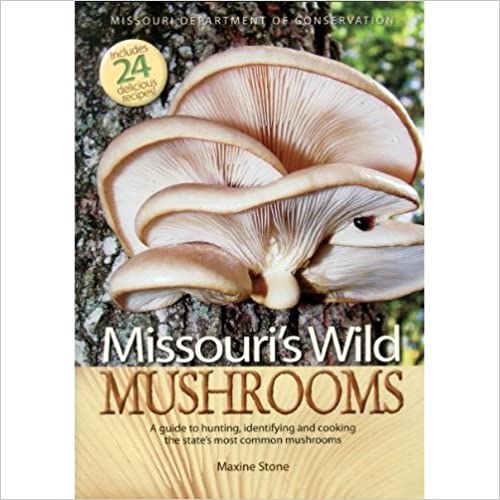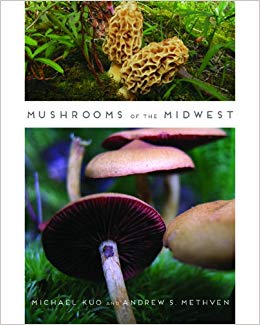Missouri is a state dominated by rivers, forest, and prairie, with rich cultural and natural history. Among other distinctions, it is the state whose conservation movement gave rise to the Wilderness Act of 1964, which allowed the designation of protected “wilderness areas” on Federal lands nation-wide[i]. Foraging for mushrooms, especially morels, is popular in Missouri.
We can’t list all of the mushroom species that grow in the state, and we aren’t going to try. Instead, here is a brief introduction to some of the more notable edible, poisonous, and “magic” species of Missouri[ii].
Our Recommended Field Guides for Missouri
COVER | TITLE | Header | ||
|---|---|---|---|---|
OUR #1 RATED | ||||
Edible Wild Mushrooms in Missouri
It seems that any time anybody mentions mushrooms, the first thing people want to know is “can I eat it?” Often, yes, you can. Lots of mushrooms are safe to eat and delicious. But we’ve got to be very clear—quick articles introducing a couple of “easy to identify” mushrooms is not a safe way to introduce people to foraging. Simply put, if you are at the stage in your mycological development where you’re learning from quick, introductory articles, you’re not ready to forage on your own, yet. It’s not that mushroom identification is all that difficult (OK, sometimes it is that difficult, just not always), it’s that paying important mushroom details is a learned skill. Until you learn to really see mushrooms, you will be vulnerable to making mistakes that could kill you.
There’s a bit of a learning curve, in other words. We’re just here to give you a few reasons to get up that hill!
If you do indeed go Mushroom Hunting make sure you have the proper tools, take a quality knife with you and a basket/bag for your haul!
This list is not meant to be used as a replacement for a field guide, spore prints, an identification app or an in person guide.
Puffballs
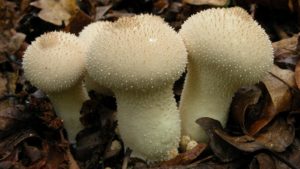

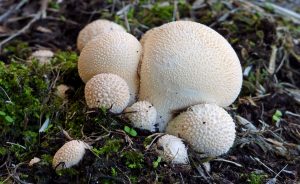

Puffballs are not a species of mushroom, nor even a genus. Instead, they are basically a shape—any ball-shaped mushroom that bears its spores on its inside is a puffball. Most aren’t closely related to each other. Some have a pore from which mature pores puff, while others release their spores by breaking open. Most are edible when young, before the spores begin to mature, while the interior is still white. Many writers insist that all puffballs are edible, but that’s an oversimplification.
First, there are ball-shaped mushrooms that are toxic, it’s just that foragers tend not to call them puffballs. These “Earthballs” are fairly easy to differentiate from edible puffballs, as they are more firm and have dark flesh (except when extremely young). Also, several non-puffballs are puffball look-alikes when very young, and some of these are dangerously poisonous. If sliced vertically, these look-alikes will look very different from real puffballs, but the trick is to remember to slice!
Missouri has at least two edible puffball species, the closely-related Common Puffball (Lycoperdon perlatum) and Stump Puffball (Lycoperdon pyriforme). Both are relatively small and have a short, thick stalk.
Shaggy Mane (Coprinus comatus)
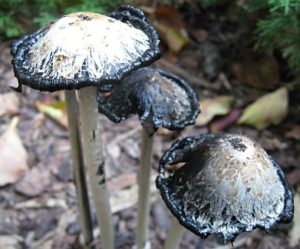

Shaggy mane is, along with its close relatives, an interesting and paradoxical edible. For one thing, as the mushroom matures, it turns to black goo, which sounds as if it ought to be disgusting, but actually many people find the goo a perfectly acceptable food dye. Anyway, the usual thing is to eat the mushroom before it starts going gooey. Second, some writers list this species as toxic, and it does contain a toxin, it’s just that the toxin is only activated by drinking alcohol. If you’re willing to go without alcohol for a few days, until the toxin clears your system, shaggy mane is fine.
Chanterelles (Cantharellus sp.)
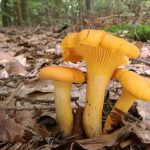



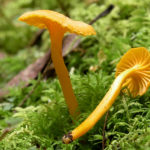

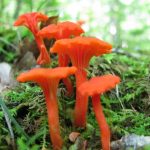

The chanterelles are a group of more or less trumpet-shaped mushrooms. The spores are born on the outside of the trumpet bell, so to speak, which is often veined or ridged. There are no gills as such. Some people restrict the name, “chanterelle,” to only members of the genus, Cantharellus, while others also apply it to members of three other closely-related genera (some of which may not be safe to eat). In any case, many chanterelles are considered delicacies.
Missouri is listed as having four species in the genus, Cantharellus: the Golden Chanterelle, (C. cibarius); the Smooth Chanterelle (C. lateritius); the Small Chanterelle (C. minor); and the Red Chanterelle (C. cinnabarinus). However, the truth might be a little more complicated. C. cibarius turns out to actually be restricted to Europe, and it’s not yet clear how many American look-alike species there are[iii]. Also, between the golden-chanterelle group and the smooth chanterelle there are intermediate forms[iv], plus there are golden chanterelles (of whatever species they may be) that are as small as small chanterelles[v].
So, basically, good luck.
Morels (Morchella sp.)
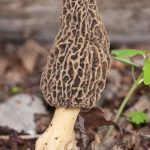

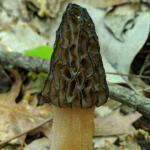



The morels are another genus that “everybody knows” are all edible, but the truth is more complicated. The issue is that even when properly prepared, morels make some people sick. It’s not clear why these mushrooms cause a problem sometimes and not others. It’s probably best to try them only in moderation at first.
Morels as a group are easy to identify; they all have the same kind of pitted, thimble-shaped cap, plus a few other distinctive features. But figuring out which morel you’ve got is harder, since several species are extremely variable or closely resemble each other. Missouri is said to have three species: M. americana, M. angusticeps, and M. punctipes.
Lion’s Mane (Hericium erinaceus)
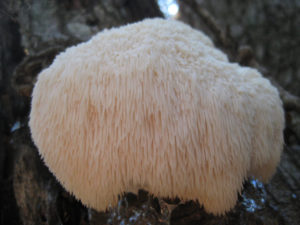

Lion’s Mane is an odd-looking mushroom, a large club-shape covered in long, white, hair-like spines. Fans of Star Trek may get a good idea of its appearance by imagining a white or yellowish tribble. Lion’s mane taste remarkably like crab meat (surprisingly, the spines don’t give it any kind of weird texture in the mouth), and it is reputed to have medicinal properties. It has several look-alikes, at least one of which can also be found in Missouri, but fortunately the look-alikes are also edible.
Chicken-of-the-Woods (Laetiporus sp.)


Chicken-of-the-woods is a group of closely-related fungi that feed on, and sometimes kill, trees. All fruit as overlapping clusters or rosettes of shelves, mostly orange in color. They were once all considered the same species, and much ink was spilled trying to figure out why that species was sometimes edible and sometimes mildly toxic. It now seems likely edibility varies with species, though it’s not yet totally clear which are the best to eat. At least two live in Missouri, L. cincinnatus, L. sulphureus, though the latter could soon be re-named.
Hen-of-the-Woods (Grifola frondosa)
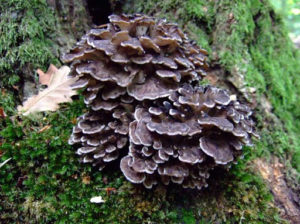

Hen-of-the-woods is not particularly related to chicken-of-the-woods, nor do the two share more than a very broad physical resemblance. Hen may get its name from the fact that it looks like a big pile of large, gray feathers. It tastes especially good cooked with cheese, like a Philly cheesestake, a cheese mushroom, if you will.
Our Recommended Field Guides for Missouri
COVER | TITLE | Header | ||
|---|---|---|---|---|
OUR #1 RATED | ||||
Poisonous Mushrooms in Missouri
The following list is not exhaustive—that is, you should not assume a mushroom is safe to eat because we didn’t say it isn’t. It’s also important to notice that the distinction between edible and poisonous can be surprisingly fuzzy with mushrooms. There are a lot of species that sicken some people but not others, and nobody knows why, or that are safe to eat cooked but not raw, or are safe to eat when young but not otherwise, and there are other complications. To a beginner, it just sounds confusing. To an experienced mycophile, it’s confusing and fascinating!
Destroying Angel (Amanita bisporigera)
There are several destroying angel species, all of them large, handsome, white or whitish mushrooms. This species is Missouri’s[vi]. Like the others, it contains a very dangerous toxin—humans who eat destroying angel can sometimes be saved if they get the correct medical intervention quickly, but diagnosis is difficult because symptoms don’t appear for hours or sometimes days after ingestion. Although destroying angels as a group are fairly distinct-looking, it is surprisingly easy for even experienced foragers to overlook the distinguishing characteristics. Destroying angel has at times been mistaken for almost every edible, white mushroom with gills in its range. Young destroying angels in their “egg” stage” can be mistaken for puffballs.
The Amanitas are a large and interesting genus that includes both poisonous and edible species—and not all the poisonous Amanitas share the same toxin. Destroying angel is not Missouri’s only Amanita, it is simply the one most likely to kill incautious foragers.
Deadly Galerina (Galerina marginata)
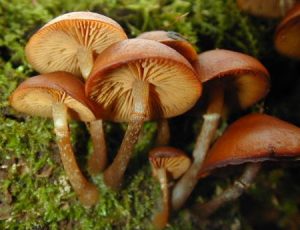

The aptly-named Deadly Galerina[vii] has the same toxin that the destroying angel does. Worse, it’s not very distinctive-looking. It’s one of the many LBMs, or “little brown mushrooms,” that look so much alike that all but the most experienced foragers should steer clear of the whole group. Unfortunately, several prized edibles and most of the “magic” mushrooms are also small, brown, and nondescript. And some of these sought-after species share the same habitat as the Deadly Galerina and can fruit with it in mixed groups. Every single mushroom on its way to a human mouth must be positively identified, since the one you gather without checking could be the one Deadly Galerina in the group.
Jack O’Lantern (Omphalotus illudens)
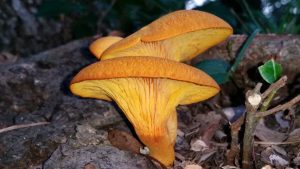

“Jack O’Lantern” refers to several closely related species. It’s not uncommon for American writers to use the name of one of the European species by mistake, but O. illudens is the American species[viii].
Jack O’Lanterns are famous for three things. The first two are resembling chanterelles and glowing in the dark. It’s debatable whether either is true. The glow is reportedly very faint, and many people have never seen it despite years of trying. And although Jack O’Lanterns are vaguely similar in color to several chanterelle species, they have gills. Chanterelles do not. It’s possible to mix them up at first glance, but no one should ever eat a mushroom based only on first glance—because the third famous thing about this species is it’s poisonous. It probably won’t kill you, but it will make you very, very ill.
False Parasol (Chlorophyllum molybdites)
The false parasol is the most consistently poisonous member of the shaggy parasol group, mushrooms that are sometimes poisonous and sometimes not. They all look very similar to each other, but the false parasol has green spores. The others usually don’t. Besides resembling the shaggy parasols, the false parasol could also be mistaken for any of several other edible species that are mostly white and have gills.
Magic Mushrooms in Missouri
Before we talk about Missouri’s psychoactive mushrooms[ix], it’s important to warn you that psilocybin, the active ingredient in these mushrooms, is extremely illegal in Missouri at both the state and Federal level[x]. There is a movement pushing for legalization, and a state law that would have allowed legal use under certain very restricted circumstances was introduced relatively recently, but it didn’t get anywhere. Someday, perhaps. In the meantime, please do not do anything with the following information that results in your arrest.
Gymnopilus sp.
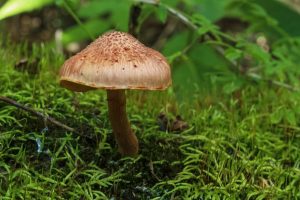

The Gyms, as they are sometimes called, are not as well-known as the Psilocybes, and there isn’t a lot of information published about what taking these mushrooms is like, but they do contain psilocybin. Reportedly, Gyms have a qualitatively different high than the Psilocybes do, suggesting some biochemical difference. At least one species, G. braendlei, grows in Missouri, but there may be others. In general, Gymnopilus mushrooms are difficult or impossible to differentiate in the field.
Banded Mottlegill (Panaeolus cinctulus)
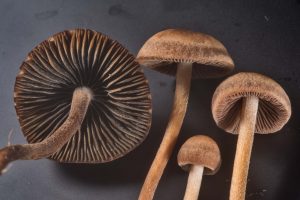

Mottlegills are so called because their spores mature and darken unevenly in spots. This species is called “banded” because the rim of the cap is a notably different shade and the center. It is moderately psychoactive.
Psilocybe sp.
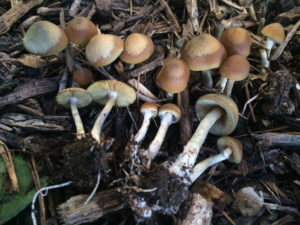

This is the most well-known of the psychoactive genera, in part because it includes Psilocybe cubensis, which is widely cultivated for both recreational and spiritual or medicinal use. P. cubensis does grow wild in Missouri, but it’s rare and not at all wide-spread. P. ovoideocystidiata[xi] also grows wild in the state and is reported to be significantly more potent than P. cubensis—but it’s more likely that potency varies a lot. It is among the species known to sometimes cause “wood-lover’s paralysis,” a poorly-understood and potentially dangerous side effect that seems to be caused by something other than psilocybin itself.
Our Recommended Field Guides for Missouri
COVER | TITLE | Header | ||
|---|---|---|---|---|
OUR #1 RATED | ||||
References:
[i] (n.d.) Missouri. Wikipedia website, accessed April 21, 2022.
[ii] Briggler, M., Leacock, P.R. (2018). A Guide to Missouri’s Edible and Poisonous Mushrooms. Missouri Department of Conservation.
[iii] Kuo, M. (2015). Catharellus “cibarius.”
[iv] Kuo, M. (2015). Catharellus lateritius.
[v] Kuo, M. (2015). Catharellus minor.
[vi] (n.d.). Destroying Angel. Missouri Department of Conservation
[vii] (n.d.). Deadly Galerina. Missouri Department of Conservation
[viii] Kuo, M. (2015). Omphalotus illudens.
[ix] (n.d.). Which Psilocybin Mushrooms Grow Wild in My Area? Shroomery
[x] Tripsitter (2022). Are Psychedelics Legal in Missouri yet? Tripsitter
[xi] Mandrake, K. (2022). Psilocybe ovoideocystidiata: The Ohio Valley Shroom Taking Over the World.


